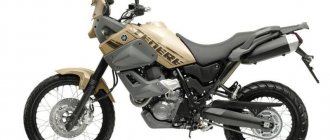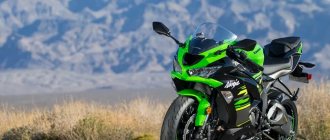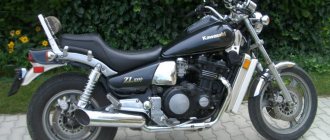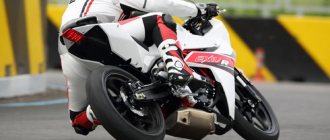| Kawasaki Zephyr 750 (1991-2006) | Kawasaki Zephyr 750 RS (1996-2002) |
Model of the classic Kawasaki Zephyr 750
first appeared in 1991. It was based on an in-line 4-cylinder engine from the sports version of the Kawasaki GPZ750, which was air-cooled and had 2 valves per cylinder. Despite the archaic nature of the Kawasaki Zephyr 750, it was produced for almost 17 years and was officially discontinued only in 2006.
Among the features of the motorcycle, it is worth noting a classic steel duplex frame, a round headlight, a simple telescopic fork at the front and a double shock absorber at the rear. The Kawasaki Zephyr 750 engine does not have outstanding technical characteristics and produces only 72 hp. power, maximum torque (59 Nm) is available already at 7500 rpm.
In 1999, as a successor to the Kawasaki Zephyr 750, a more modern Kawasaki ZR-7 model appeared on the market, which had the same old air 8-valve engine (albeit slightly modified). The Kawasaki Zephyr 750 model continued to be produced in parallel until 2006.
Main modifications:
- Kawasaki Zephyr 750
is the regular version of the motorcycle. - Kawasaki Zephyr 750 RS
- version with classic spoked wheels.
Model range of the Kawasaki Zephyr series:
- Kawasaki Zephyr 400
- Kawasaki Zephyr 550
- Kawasaki Zephyr 750
- Kawasaki Zephyr 1100
The main competitors of the Kawasaki Zephyr 750 in the class:
- Honda CB 750
- Suzuki GSX750 Inazuma
Brief history of the model
- 1991 - start of production and sales of Kawasaki Zephyr 750.
Model
: Kawasaki Zephyr 750 (Japan, Europe, North America).
Factory designation
: ZR750-C1.
- 1992 - no significant changes.
Model
: Kawasaki Zephyr 750 (Japan, Europe, North America).
Factory designation
: ZR750-C2.
- 1993 - no significant changes.
Model
: Kawasaki Zephyr 750 (Japan, Europe, North America).
Factory designation
: ZR750-C3.
- 1994 - Model no longer available in North America.
Model
: Kawasaki Zephyr 750 (Japan, Europe).
Factory designation
: ZR750-C4.
- 1995 - no significant changes.
Model
: Kawasaki Zephyr 750 (Japan, Europe).
Factory designation
: ZR750-C5.
- 1996 - appearance of the RS modification with spoked wheels.
Model
: Kawasaki Zephyr 750 RS (Japan, Europe).
Factory designation
: ZR750-D1.
- 1997 - no significant changes.
Model
: Kawasaki Zephyr 750 RS (Europe).
Factory designation
: ZR750-D2.
- 1998 - no significant changes.
Model
: Kawasaki Zephyr 750 RS (Europe, Japan).
Factory designation
: ZR750-D3.
- 1999 - Model no longer available in the European market. Instead of the Zephyr, a new model was introduced - the Kawasaki ZR-7.
Model
: Kawasaki Zephyr 750, Kawasaki Zephyr 750 RS (Japan).
Factory designation
: ZR750-C6, ZR750-D4.
- 2001 - no significant changes.
Model
: Kawasaki Zephyr 750, Kawasaki Zephyr 750 RS (Japan).
Factory designation
: ZR750-C7, ZR750-D5.
- 2002 - no significant changes. Last year of production of the RS modification.
Model
: Kawasaki Zephyr 750, Kawasaki Zephyr 750 RS (Japan).
Factory designation
: ZR750-C8, ZR750-D6.
- 2003 - no significant changes.
Model
: Kawasaki Zephyr 750 (Japan).
Factory designation
: ZR750-C9.
- 2004 - no significant changes.
Model
: Kawasaki Zephyr 750 (Japan).
Factory designation
: ZR750-C10.
- 2005 - no significant changes.
Model
: Kawasaki Zephyr 750 (Japan).
Factory designation
: ZR750-C11.
- 2006 is the last year of production.
Model
: Kawasaki Zephyr 750 (Japan).
Factory designation
: ZR750C6F, ZR750C6FA, ZR750C6S, ZR750C6SA.
Motorcycle Kawasaki ZR 400 Zephyr 1992 review
Description of the Kawasaki ZR 400 Zephyr 1992 motorcycle is in the queue for publication of the article. Announcement: Today, for almost every new motorcycle that comes into being, marketers strive to carve out their own niche. This one is a road sport, this one is a recreational enduro. But what class should we include a motorcycle that has a little bit of everything? A good bike should have a reliable engine, comfortable ergonomics and simple controls...
Kawasaki ZR 400 Zephyr is a motorcycle rarely sold in Russia, equipped with a high-power 49 hp engine. Despite the fact that good models of motorcycles have a very respectable price, and the season for their use is relatively short, the motorcycle market is developing rapidly. And if you believe the words of dealers, then some models of recently released motorcycles are selling like hot cakes at the beginning of the season, and the models brought to Russia are clearly not enough to fully satisfy consumer demand.
A motorcycle has long ceased to be an alternative to a car, and the times when this equipment was bought only because there was not enough money for a full-fledged car are forgotten. Nowadays, two-wheelers can be called technological marvels in many cases, and their cost can be compared with that of prestigious cars.
Many people have started buying motorcycles for hobby purposes as riding or even collecting them has become a good pastime for many people. Many motorcycles, for example the Kawasaki ZR 400 Zephyr, whose technical characteristics make it possible to call the model a prestigious brand, are in demand among both beginners and experienced motorcyclists.
Currently, it is impossible to purchase a new Kawasaki ZR 400 Zephyr motorcycle from the 1992 model year, since their production stopped 24 years ago. At the same time, the Kawasaki ZR 400 Zephyr has excellent technical characteristics, so many are eager to purchase, if not a new, then at least a used version.
Motorcycles with an engine capacity of 399 cc / 24.4 cu-in. see, appeared as a result of long work of inventors who sought to create a model that was not inferior in characteristics to other versions of the motorcycle. In some cases, these models are not only not inferior, but also ahead of other motorcycles, as they have minimal fuel consumption and other excellent parameters.
Motorcycles from 250 to 400 kb. see which includes the Kawasaki ZR 400 Zephyr - this is the most common class of motorcycles. In this range you already have a choice among almost all classes of motorcycles. Many people call this category the most suitable for a first motorcycle. You can purchase a moderately heavy, powerful and flexible motorcycle for relatively little money. Many people advise taking a road bike with a 400 cc engine as your first choice. We cannot completely agree with this, because such motorcycles often weigh about 200 kg and have a sufficient power reserve. If your skills in riding a two-wheeled vehicle are limited to a training motorcycle at a motorcycle school, then you should not immediately take such a device. Many beginners get into ridiculous accidents simply because they do not know all the features of operating such equipment. After all, the heavier and more powerful the motorcycle, the better you should know how to handle it in different situations. Even a monkey can just drive in a straight line (no joke).
Go to the entire range of Kawasaki motorcycles, on this page you can find Kawasaki ZR 400 Zephyr motorcycles of other years and information about them
Specifications
Technical characteristics of Kawasaki Zephyr 750:
| Model | Kawasaki Zephyr 750 |
| Motorcycle type | classic |
| Year of issue | 1991-2006 |
| Frame | steel tubular |
| engine's type | 4-cylinder, 4-stroke, in-line |
| Working volume | 738 cm³ |
| Bore/Stroke | 66.0 x 54.0 mm |
| Compression ratio | 9.5:1 |
| Cooling | air |
| Number of valves per cylinder | DOHC, 2 valves per cylinder |
| Fuel supply system | carburetor, 4x Keihin CVK32 |
| Ignition type | fully transistorized |
| Maximum power | 68.0 hp (50.0 kW) at 9500 rpm – Zephyr 750 (Japanese versions) 72.0 hp (53.0 kW) at 9500 rpm - Zephyr 750 (European versions, 1991-1995) 76.0 hp (56.0 kW) at 9500 rpm - Zephyr 750 (European versions, 1996+) |
| Maximum torque | 54.0 Nm (5.5 kg*m) at 7500 rpm - Zephyr 750 (Japanese versions) 59.0 Nm (6.0 kg*m) at 7500 rpm - Zephyr 750 (European versions, 1991- 1995) |
| Clutch | Multi-disc in oil bath, cable drive |
| Transmission | 5-speed |
| type of drive | chain |
| Front tire size | 120/70-17 (58H) |
| Rear tire size | 150/70-17 (69H) |
| Front brakes | 2 discs, 300 mm, 2-piston calipers |
| Rear brakes | 1 disc, 240 mm, 2-piston caliper |
| Front suspension | 41 mm telescopic fork (non-adjustable), travel - 140 mm |
| Rear suspension | pendulum with two shock absorbers (non-adjustable), stroke - 115 mm |
| Motorcycle length | 2105 mm |
| Motorcycle width | 770 mm |
| Motorcycle height | 1095 mm |
| Wheelbase | 1455 mm |
| Seat height | 780 mm |
| Minimum ground clearance (clearance) | 150 mm |
| Acceleration 0-100 km/h (0-60 mph) | 3.9 sec[1] |
| Maximum speed | 195 km/h[2] |
| Gas tank capacity | 17.0 l (including reserve - 3.0 l) |
| Motorcycle weight (dry) | 201 kg – Zephyr 750 212 kg – Zephyr 750 RS |
KAWASAKI Zephyr 1100
For a long time the image of the last accident did not subside in my memory. Therefore, in order to roll it out and get a taste for it again, I decided to take a quiet “400”. This is how the Kawasaki Zephyr fell into my hands - it looks like a very calm classic, but in character... I can’t say that at the time of purchase the Kawasaki ZR400 was the best in its class. But what captivated me was that he arrived in Moscow at the beginning of 2002, bypassing all the “cheating” authorities (the pre-sale alone is worth it!) of well-known motorcycle dealerships and private dealers. An acquaintance brought him directly from Japan, and I was the first to open Russian roads to him. The inspection showed that there was a small group of technical issues. However, what would we do without them, because the motorcycle is by no means a boy’s age. But there was no doubt that he was in good hands there and loved. One could also believe in the reality of the numbers on the odometer - 22,000 km in Japan. How much more will it take?
In general, I was pleased with the choice. No rust on the chrome or iron, all screws and hoses are original, condition - literally sat down and drove off. The four-cylinder engine ran smoothly, squealing with a sound typical of a 400 after 10,000 rpm and did not seem “tired” at all. The first ride proved this once again: the motorcycle rushed forward, without even thinking about being “stupid.” He easily responded to the turn of the throttle, quickly picked up speed and demonstrated effective work in the red zone. I admit that before this I had heard a lot of stories about the abilities of the “four hundred”.
They say that they only know how to buzz, and they can only ride “at the top.” Perhaps this feature is characteristic of sportbikes, but my neoclassic was strikingly different in the elasticity of the engine characteristics. There were no dips at the bottom; acceleration was observed immediately from 3000 rpm. But, but, but... With all this, Zephyr immediately showed the whole range of neoclassical nuances. Soft suspension or flimsy frame. The “native” setting of the rear shock absorbers turned out to be not soft, but very soft. So we had to do some magic with pumping air and preloading the springs in order to “acclimatize” them to our asphalt.
But be that as it may, the crushing of the rear wheel in deep turns remained. As, indeed, is the general softness of the chassis. On uneven surfaces, and especially in areas with cut layers of asphalt (there is no talk of paving stones), you immediately feel how it all moves like a screw. The first days of riding the Kawasaki convinced me of one rule, which later guided me - it is better to ride this Zephyr on a well-calibrated fairway. So in the future, madness and annealing were allowed only on those roads in which I was confident and which I knew well.
The device fits perfectly into my vehicle concept. I don’t have a dacha, I move exclusively around the city and every day - to work, to meetings, to hang out with friends. And I will say without exaggeration that for such purposes this “Kava” completely justified itself. In the street crowd, the engine power and controllability of the motorcycle were more than enough. Moreover, already in the first thousand, I completely “tailored” it to this topic. First of all, I removed the standard mirrors. Not because I didn’t like them (on the contrary, the style was all right here).
But in the miniature rectangles I could only see a fragment of a car, and they were located too low. For $20 I bought magnificent mirrors: large, round and on a high leg. So everything was in order with orientation in the traffic flow. Then it was the turn of the muffler. Alas, the stock exhaust always remains stock. Therefore, without hesitation, I did a little magic on the “flute”, and the “old man” received a pleasant polyphony, pleasing the ears of not only the current owner, but also other participants in the movement. The motorcycle became not only visible on the road, but also audible.
But what struck me most was the “box”. To say that it works well is to say nothing. No noise, crisp shifting, easy neutral, no false positives. As far as I know, only Honda units work this way. Kawasaki designers seem to have tried to outdo their competitors, and they succeeded. The programs are “stuck in” as if by thought, and the only thing that irritated me at first was their number. The six-speed gearbox is a necessary addition to the 400cc size. If you want to drive, know how to click!
Testing the clutch did not reveal any negative things, but the original drive sprocket did not inspire much confidence, and therefore the device soon received tuning from Afam. The result is obvious. 1500 km, and the old chain took its place in the landfill. I had to fork out another $120. NGK spark plugs and silicone wires completely deprived the engine of the tendency to periodically trim and hang.
What's the end result? The already frisky “old man” further aggravated his “pepper” character. We turn the throttle and easily place the speedometer needle beyond the 180 km/h mark (the tachometer needle is in the middle of the “red zone”!). Of course, with Schwarzenegger's hands and a concrete head. After all, at speeds over 140 km/h, it simply rips off the motorcycle, and even hugging the gas tank doesn’t help much. A classic is a classic. However, for lovers of country driving, a tuning fairing will cost about $50-70 - a variety of insects is no longer a hindrance to you.
There was also a fall. And, as it turned out, this “Japanese” knows how to fall intelligently without compromising the owner’s budget. Rolling onto its side at a speed of 60 km/h only resulted in a damaged turn signal, ground off handle and roll bar. By the way, the latter saved the engine cheek from asphalt disease. I admit that in the first season I liked to experiment. But, in the end, I came to where I started: this is a city motorcycle. A good start, maneuverability, unpretentiousness, efficiency - everything a city dweller needs. Then winter came and problems began. There was no warm garage, and as a result: replacing both front fork seals, which included a rebuild and oil change, cost $110.
The first spring trip took with me an old, still “original” battery. Then I got the hang of it and started changing and repairing everything that was responsible for the viability of the motorcycle. Complete cleaning and washing of four carburetors is a simple and inexpensive operation. Got stable idle speeds and intense acceleration. The tires on which the Zephyr arrived from Japan and “trampled” the whole season in Moscow were happily disposed of, and the brand new Batlax from Bridgestone “stuck” to the alloy wheels as if they were original. And one more detail haunted me - the huge archaic turn signals. They had been asking for the trash heap for a long time, and their wish was finally fulfilled. Four catalog babies took their regular places, taking with them another $36.
Such a massive financial start to the second season determined a generally problem-free further operation. The device drove and drove, convincing every thousand of its reliability and unpretentiousness. "Japanese" is "Japanese"! After a thorough inspection, the brake discs received the right to further life. Thanks to our Japanese colleagues for the timely change of pads.
Now about appetite. Gasoline consumption on “older” engines is a rather strange thing. If you drive in average mode up to 120-140 km/h, then “Kava” will “eat” about 5-6 liters per “hundred”. But if you turn the engine to the “red zone”, then a dozen liters are guaranteed. However, for true lovers of “hitting” or “playing checkers”, fuel consumption will never become a stumbling block. Do you remember where I started my story? I wanted to ride it out, to nullify the post-accident syndrome. And the Kawasaki Zephyr helped me do this. Despite his decent age, this “Japanese” is still full of determination and strength. But he needs to be given attention as an elderly person. So if you have a little patience and the desire to sometimes deal with the problems of old age, then a fleeting friendship with him can develop into a protracted one. How it happened for me. I wanted a motorcycle “for a week”, but it turned out... What can I say, I don’t want to part with it. After all, its content is not at all expensive.
Reviews
Kawasaki Zephyr 750 reviews:
Expand Collapse
I also bought myself a Zephyr 750. True, I have a ’96 750D, on spoked wheels. It rushes like a wild boar, the traction is simply insane, after the Urals it seems like a sportbike (although it is far from being one). At night, along the highway in traffic, the same 120-130 go normally, without fear that it will eat the crosspieces, overheat and explode.
One time I unscrewed the stink too recklessly, so he stood up in the candle, my ass shrank beyond recognition. But he eats 8 liters per hundred, bitch. The Urals with Keikhins are more economical. Well, in general, in the speed segment up to 90 mph, the Ural is better and more pleasant.
I continue the story of how I repair the engine of my beloved Kawasaki Zephyr 750 with almost 100,000 km of mileage. the first part is here.
Let's start with the fact that after removing the engine from the motorcycle, the first thing I did was throw it in the trunk and take it to wash =) I washed it long and hard, but due to lack of experience, I missed many hidden places where dirt was hidden, which later safely ended up in the disassembled engine as it was removed separate parts. But this is not scary, since the engine is completely disassembled.
Of course, having brought the engine after washing, at 12 at night =), I could not help but start disassembling it, the structure and condition were very interesting. The first thing I saw was a dangling timing chain, but this was not a surprise, because of this rattling chain the disassembly of the engine was started. The chain has been sitting and waiting for 2 years =).
The next step, purely out of interest, I started measuring the valve and camshaft clearances. Here I must say I was pleasantly surprised - the camshafts were like new, and in the future I was repeatedly convinced that the former owner turned out to be a pedant when it came to changing the oil, changed it on time and did not skimp on finding out what kind of oil he poured. But he neglected valve adjustment! the exhaust gaps are less than the minimum, and therefore almost all the valves are a little burnt, I checked the tightness by pouring gasoline into the intake and exhaust channels, and only one valve did not leak =(. I’ll run ahead and say that I fixed it by grinding the valves, using it as a paste for grinding with an ordinary polishing paste for metal, since it is minimally fine in consistency, which suits the condition of the valves and seats. The valves themselves, their legs and guides are very close to ideal condition, the valve stem seals allowed oil to pass through, the old ones were used for replacement =) I assembled the head, but I can’t get around to measuring the new gaps and calculating which washers need to be ordered.
I looked at the manual for a long time, crawled around the net, and still couldn’t find which cylinder was the first to put it at dead center, etc... but in the manual everything is simple - you turn the engine until the camshafts are in the desired position, on one side there is an intake mark on the other, an exhaust mark, The ignition also moves to a certain position, everything is simple and clear.
Having removed the head, I saw carbon deposits on the pistons and head, it doesn’t seem to be much, but there is, this is a consequence of outdated valve stem seals, and maybe rings...
When removing the head from the studs, dirt accumulated in places out of reach, dirt got inside the engine... not pleasant, but fixable.
Next, I removed the pistons from the connecting rods, the fingers fit tightly and do not wiggle here and there, so I had to try hard to get them out, 3 pressed them out using an ordinary small clamp, and one had to be knocked out =( how the hell do you put them back then?.. measurements of pistons, rings and the cylinders also showed that everything seems to be normal. The cylinders are like new according to measurements =), the pistons in a new state should be 65.95mm, I have 65.92-65.90 mm and the limit is 65.81mm, I think the pistons should not be touched. The rings are far from the limit, but they have gone beyond the standard, I will exchange them for a standard size.
After removing the pistons, all that remains is to split the block. here I fiddled around for a day leisurely drinking a beer, because I can’t understand the pictures in the manual, and I can’t understand the English, and the German has no details at all, but I have 2 Pallas cats - English and German, and a printout of the parts catalog with numbers where I immediately I note what parts I need, so that later it will be easier to search and order.
I broke 4 bolts in the block =(((sad mother of her leg... well, never mind, I’ll drill it out. Having opened the block =) the box and the knee appeared before my eyes. I’ll immediately note that I didn’t remove the clutch basket and flywheel - why? They don’t bother me , and unscrew the bolts on the removed engine that are tightened to 130 Newtons, oh well... The first thing that bothered me was the primary transmission chain from the knee to the box, and it upset me, the maximum sag is 25mm, and I have 35mm, that’s another reason “ "ringing" engine operation at idle. It upset me because the infection costs 200 dollars =(...
The clutch also made my soul happy =) the salesman didn’t lie when he said that the clutch is new =) it’s really new, and along the way I’m driving correctly because in my 2 driving seasons, the clutch has remained like new, measurements within the standard.
All the gears in the box seem to have no visible problems. You just need to figure out how to get to the starter overrunning clutch in order to replace the springs and rollers, let me remind you that lately the motorcycle has not wanted to start, the starter was idling, occasionally grabbing the engine. Tomorrow I will order the necessary parts, in addition to what has already been ordered. In principle, everything is very simple, but there is not enough experience to determine by eye what is used and what is not. But my dear dad is always there, who will always advise and help; by the way, he serviced the head and ground the valves, so there are no photos for that. if I assemble it and everything works as it should, then I will be sure that I can sort out this engine in the field =)))
Good night everyone, and have a productive working week! If you have any comments or advice, I’ll be glad to hear it!








